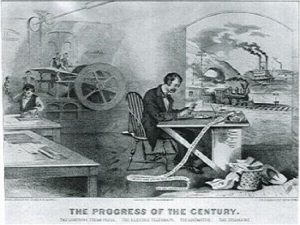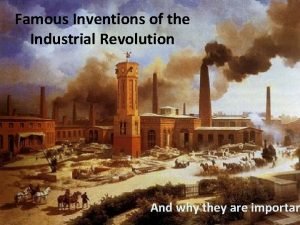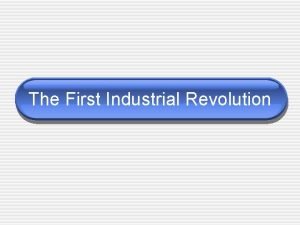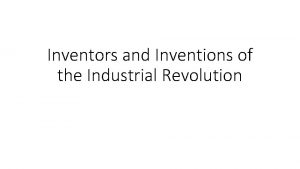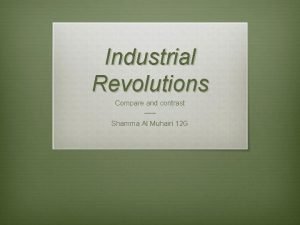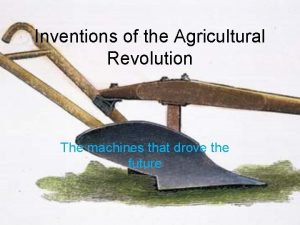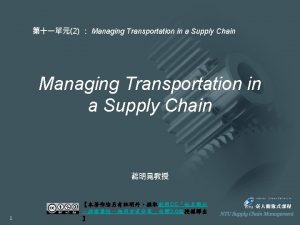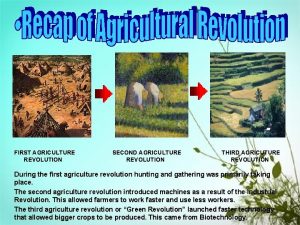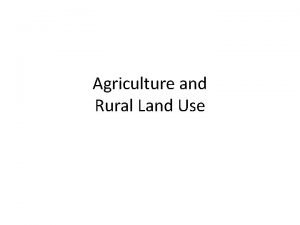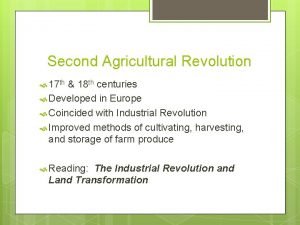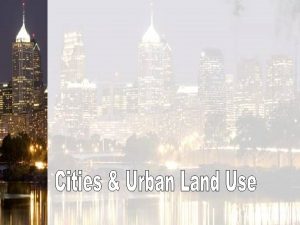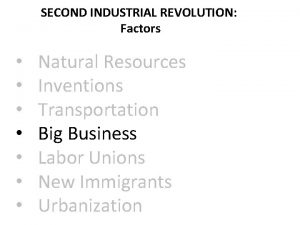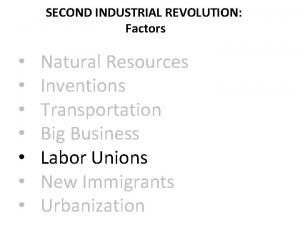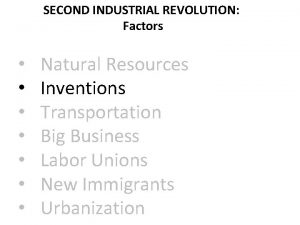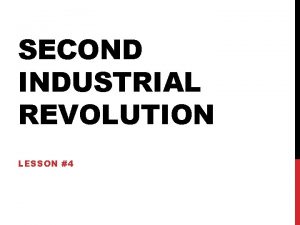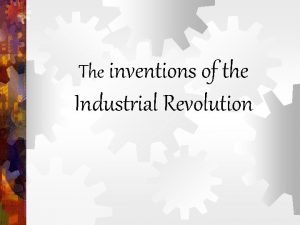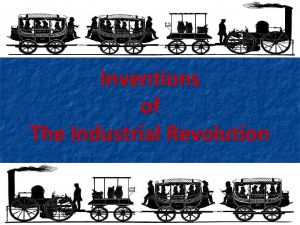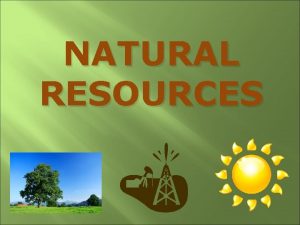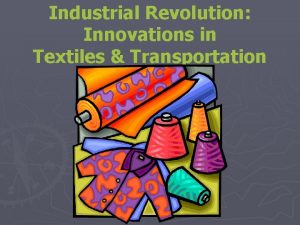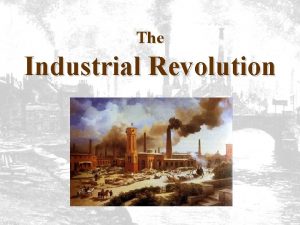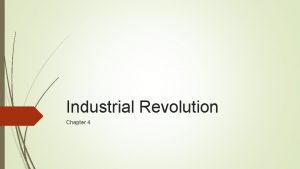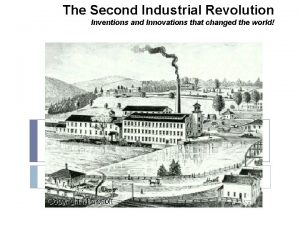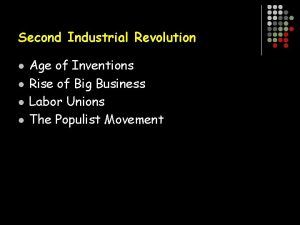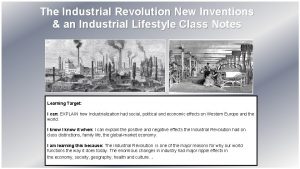SECOND INDUSTRIAL REVOLUTION Factors Natural Resources Inventions Transportation




















- Slides: 20

SECOND INDUSTRIAL REVOLUTION: Factors • • Natural Resources Inventions Transportation Big Business Labor Unions New Immigrants Urbanization

The Industrial Revolution Previously On: • We looked at the inventions that came out of the Industrial Revolution Today On: We are going to look at how the building of a railroad across the United States changed the country

SECOND INDUSTRIAL REVOLUTION: Transportation • • • The development of railroads made possible for the natural resources of the country to speed through our economy for the first time Before the steam engine, raw materials and finished goods transported via horse-drawn wagons, and by boats along canals and rivers This new and improved transportation system was crucial for raw materials to reach the factories and manufactured goods to reach consumers in rapid time.

SECOND INDUSTRIAL REVOLUTION: Transportation • • • The building of a railroad that linked the entire country, the “Transcontinental Railroad”, dramatically changed the United States The railroad united the very diverse regions of our country (East and West), helped move people west, helped transport goods and materials, and changed the way of life for many Americans. Realizing how important railroads were for settling the West and for developing the country, the government made huge land grants and loans to railroad companies to build the rails

SECOND INDUSTRIAL REVOLUTION: Transportation • • • The railroad boom began in 1862 when President Abraham Lincoln signed the Pacific Railway Act In 1860, there were no railroad tracks running from Nebraska to California Railroads in eastern states, but none in the west This act called for the construction of a transcontinental railroad “Transcontinental” means “crossing a continent” The rapid construction of railroads accelerated the nations industrialization and linked the country together

Railroads before 1860


• • • SECOND INDUSTRIAL REVOLUTION: Transportation Since there were no train tracks, had to travel by wagon to California Trip would take 5 months Cost would be $1, 000 o Wagon o Oxen o Cows o Camping Material o Clothes for warm/cold weather o 5 months food supply

SECOND INDUSTRIAL REVOLUTION: Transportation • Hardships from the trip: • Sickness • Crossing rivers • Robbed by bandits • Mountain passing • Dangerous animals • Surviving the cold



SECOND INDUSTRIAL REVOLUTION: Transportation Who built this railroad? Central Pacific: • Hired 10 k workers from China who were living in California • Paid them $1 a day • Chinese were considered an inferior race due to racism Union Pacific: • Hired Irish immigrants & Civil War veterans


SECOND INDUSTRIAL REVOLUTION: Transportation Conditions • Blizzards in the mountains • Scorching desert heat • Suffered bloody attacks on its workers by Native Americans who were threatened by the progress of the white man and his “iron horse” across their native lands



SECOND INDUSTRIAL REVOLUTION: Transportation Advantages • • • This spurred American industrial growth by linking the nation Affected our economy: now goods and services would be available in many different places. American Railway divided the country into 4 time zones Helped unite Americans from different regions Americans could now travel and see the country Travel time to California in half the time

SECOND INDUSTRIAL REVOLUTION: Transportation

SECOND INDUSTRIAL REVOLUTION: Transportation

Jobs • The transcontinental railroad led to the creation of new technologies and jobs q Textile workers made fabric for seats q Glassworkers made windows q Increased demand for coal to power trains and to melt to make iron q Needed more iron and coal miners , iron workers, boilers, steel parts q Lumber industry needed to make tracks
 Industrial revolution natural resources
Industrial revolution natural resources Famous inventions of the industrial revolution
Famous inventions of the industrial revolution Interchangeable parts
Interchangeable parts Industrial revolution inventors and inventions
Industrial revolution inventors and inventions Manet, olympia, 1863
Manet, olympia, 1863 First and second industrial revolutions
First and second industrial revolutions Agricultural revolution inventions
Agricultural revolution inventions Newton's first law of motion
Newton's first law of motion Factors affecting transportation decisions
Factors affecting transportation decisions 27 miles per gallon into kilometers per liter
27 miles per gallon into kilometers per liter Agricultural revolution
Agricultural revolution Whittlesey agricultural regions
Whittlesey agricultural regions Edge city ap human geography
Edge city ap human geography The second agricultural revolution coincided with
The second agricultural revolution coincided with First urban revolution hearths
First urban revolution hearths Russian revolution vs french revolution
Russian revolution vs french revolution You should hope this game will be over soon
You should hope this game will be over soon Third agricultural revolution definition
Third agricultural revolution definition The writing revolution resources
The writing revolution resources What is transforming resources
What is transforming resources Differentiate fixed resources and variable resources
Differentiate fixed resources and variable resources
